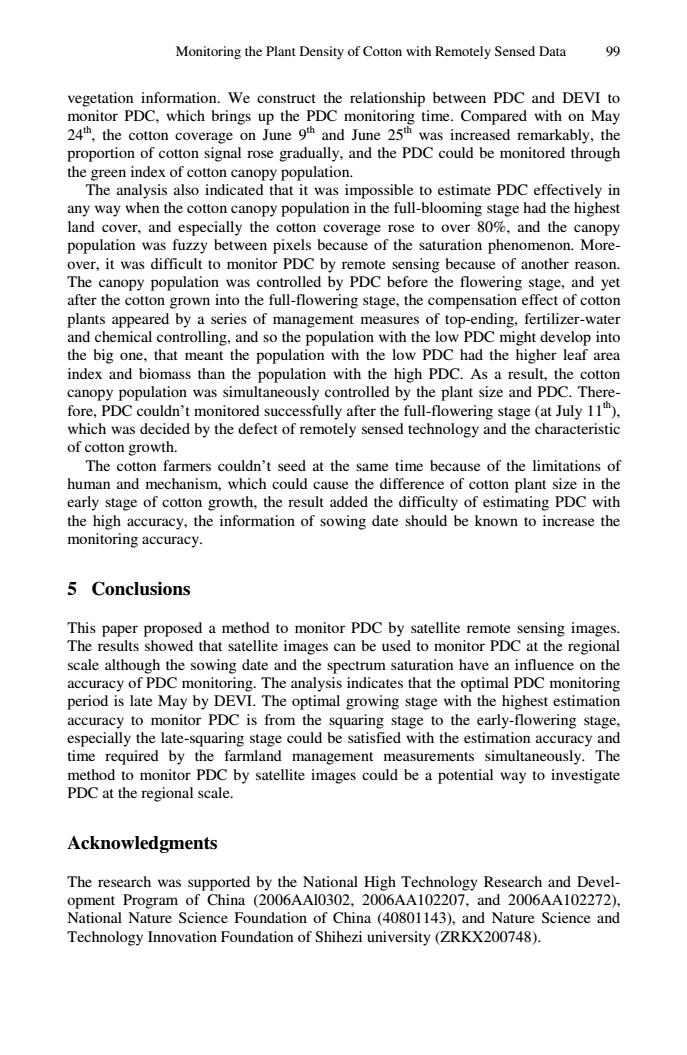正在加载图片...

Monitoring the Plant Density of Cotton with Remotely Sensed Data 99 vege 24 itoring time. on May tton coverage proportio the green index of cotton canopy population The analysis also indicated that it was impossible to estimate PDC effectively in any way when the cotton canopy population in the full-blooming stage had the highest land cover,and especially the cotton coverage rose to over 80%,and the canopy population was fuzzy between pixels because of the saturation phenomenon.More over,it was difficult to monitor PDC by remote sensing because of another reason The canopy population was controlled by PDC before the flowering stage,and yet after the cotton grown into the full-flowering stage,the compensation effect of cotton plants appeared by a series of management measures of top-ending,fertilizer-water and chemical controlling,and so the population with the low PDC might develop into the big one,that meant the population with the low PDC had the higher leaf area index and biomass than the r pulation with the high PDC.As a result,the cotton canopy population was simultaneously controlled by the plant size and PDC.There fore PDC couldn't monitored successfully after the full-flo ering stage (at July 11) which was decided by the defect of remotely sensed technolo and the characteristic of cotton growth. The of which ce e the diff of e plant si t information of sowing date should monitoring accuracy. 5 Conclusions This pape ren The ed that be use images scale altho wing date and th ses can regio m satu on th m The optimal growing stage accuracy【O early-f ering stage especially on acc time required by the farmlan simultaneously. The method to monitor PDC by satellite images could be a potential way to investigate PDC at the regional scale. Acknowledgments 6AA Technology Innovation Foundation of Shihezi university(ZRKX200748).Monitoring the Plant Density of Cotton with Remotely Sensed Data 99 vegetation information. We construct the relationship between PDC and DEVI to monitor PDC, which brings up the PDC monitoring time. Compared with on May 24th, the cotton coverage on June 9th and June 25th was increased remarkably, the proportion of cotton signal rose gradually, and the PDC could be monitored through the green index of cotton canopy population. The analysis also indicated that it was impossible to estimate PDC effectively in any way when the cotton canopy population in the full-blooming stage had the highest land cover, and especially the cotton coverage rose to over 80%, and the canopy population was fuzzy between pixels because of the saturation phenomenon. Moreover, it was difficult to monitor PDC by remote sensing because of another reason. The canopy population was controlled by PDC before the flowering stage, and yet after the cotton grown into the full-flowering stage, the compensation effect of cotton plants appeared by a series of management measures of top-ending, fertilizer-water and chemical controlling, and so the population with the low PDC might develop into the big one, that meant the population with the low PDC had the higher leaf area index and biomass than the population with the high PDC. As a result, the cotton canopy population was simultaneously controlled by the plant size and PDC. Therefore, PDC couldn’t monitored successfully after the full-flowering stage (at July 11th), which was decided by the defect of remotely sensed technology and the characteristic of cotton growth. The cotton farmers couldn’t seed at the same time because of the limitations of human and mechanism, which could cause the difference of cotton plant size in the early stage of cotton growth, the result added the difficulty of estimating PDC with the high accuracy, the information of sowing date should be known to increase the monitoring accuracy. 5 Conclusions This paper proposed a method to monitor PDC by satellite remote sensing images. The results showed that satellite images can be used to monitor PDC at the regional scale although the sowing date and the spectrum saturation have an influence on the accuracy of PDC monitoring. The analysis indicates that the optimal PDC monitoring period is late May by DEVI. The optimal growing stage with the highest estimation accuracy to monitor PDC is from the squaring stage to the early-flowering stage, especially the late-squaring stage could be satisfied with the estimation accuracy and time required by the farmland management measurements simultaneously. The method to monitor PDC by satellite images could be a potential way to investigate PDC at the regional scale. Acknowledgments The research was supported by the National High Technology Research and Development Program of China (2006AAl0302, 2006AA102207, and 2006AA102272), National Nature Science Foundation of China (40801143), and Nature Science and Technology Innovation Foundation of Shihezi university (ZRKX200748)